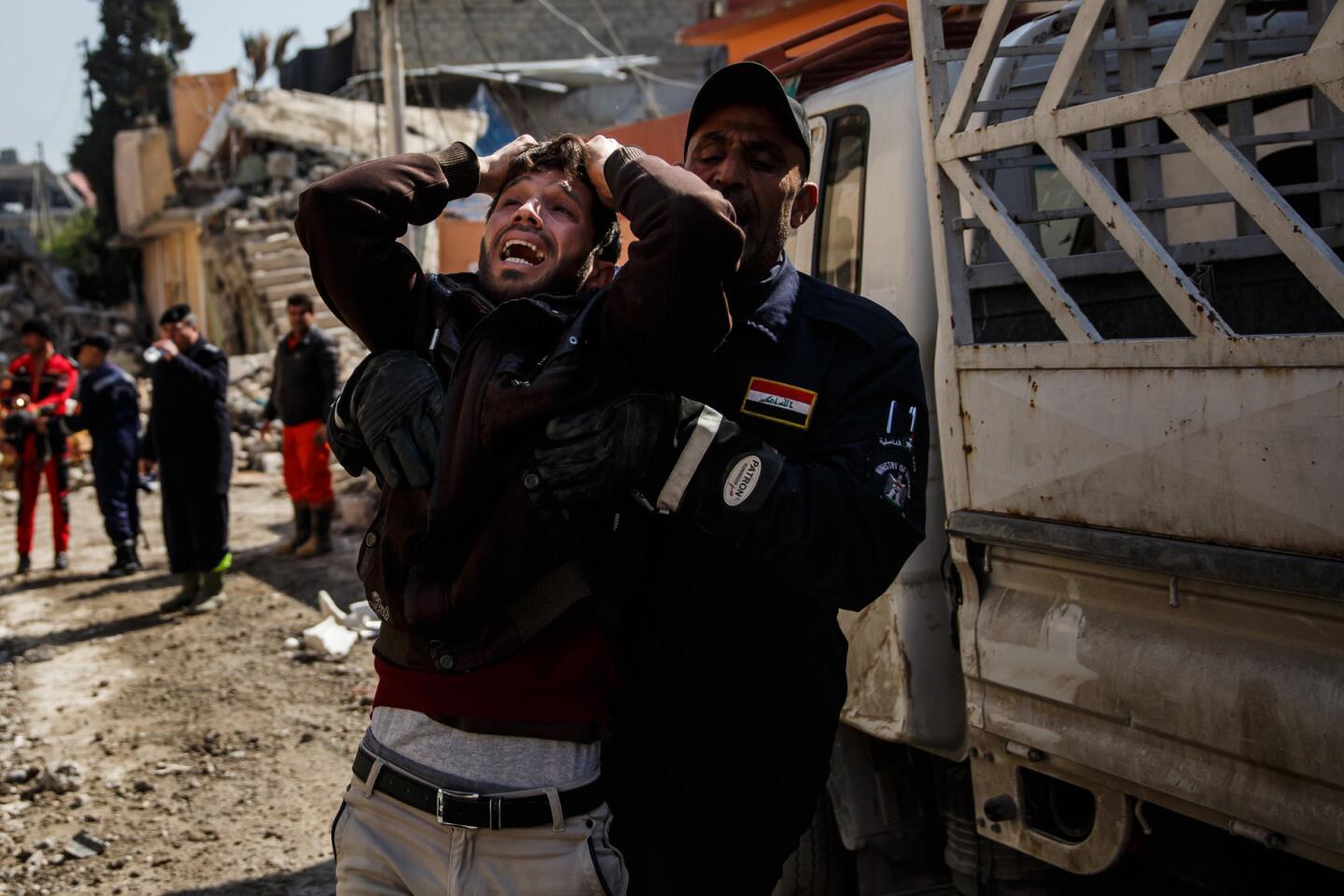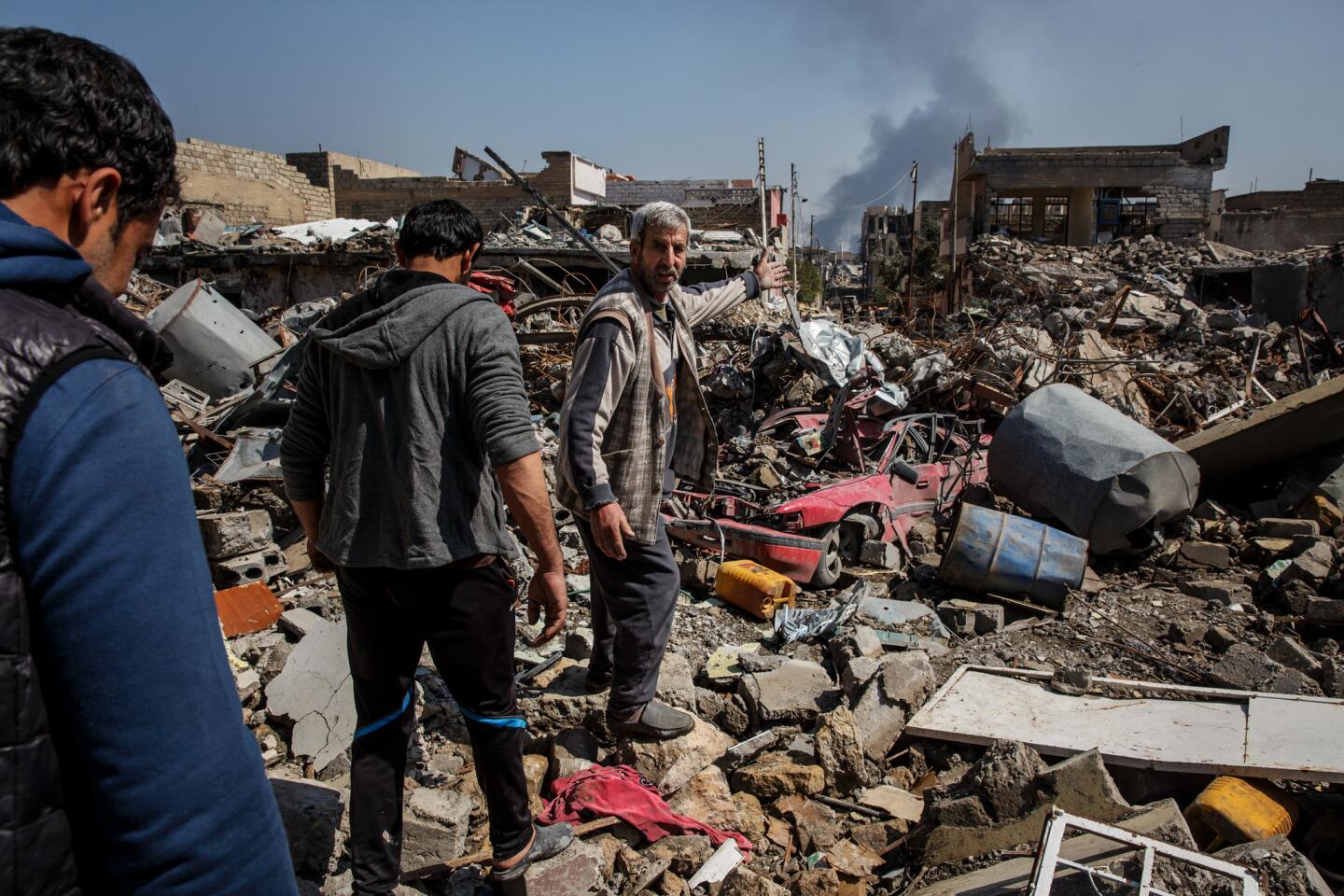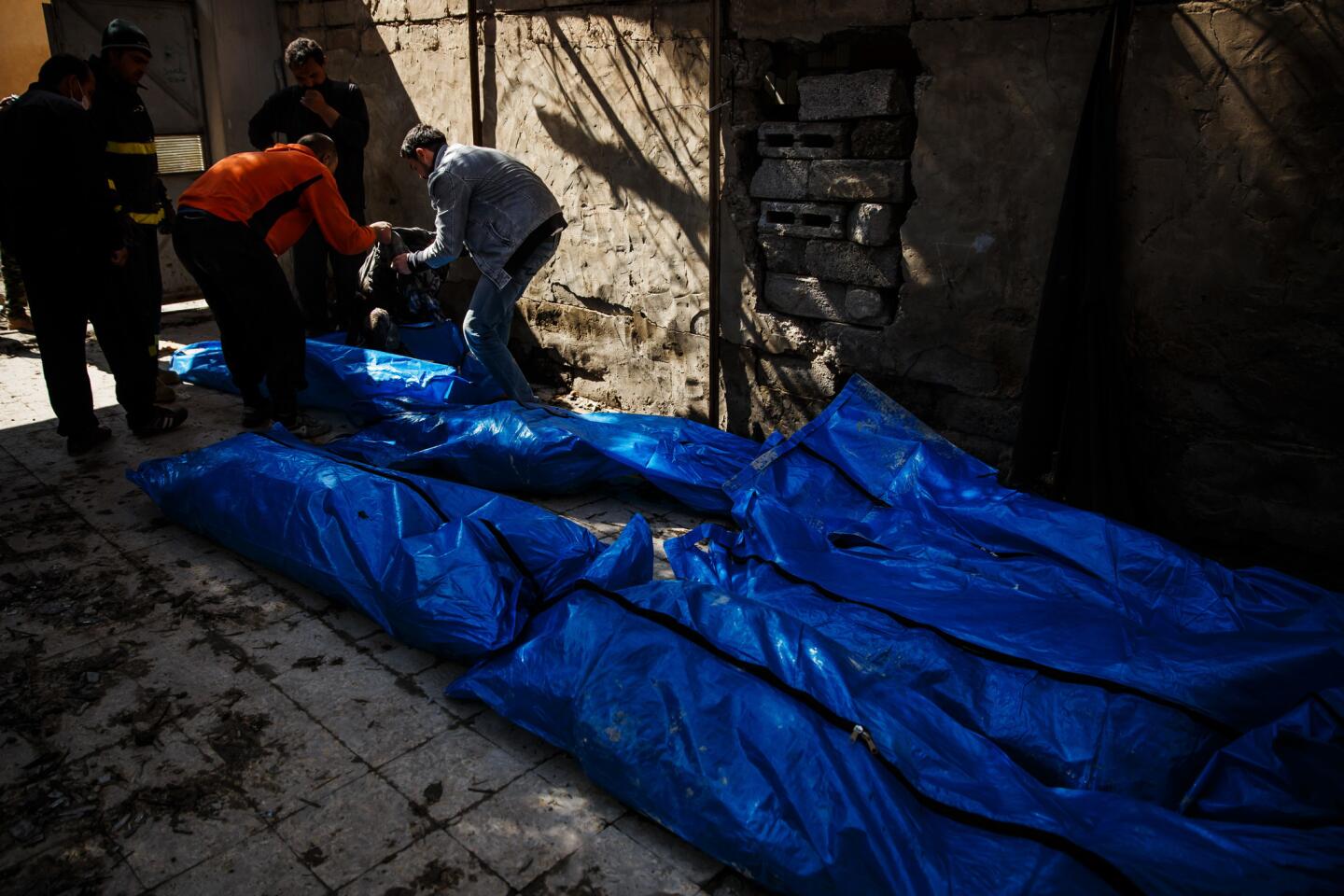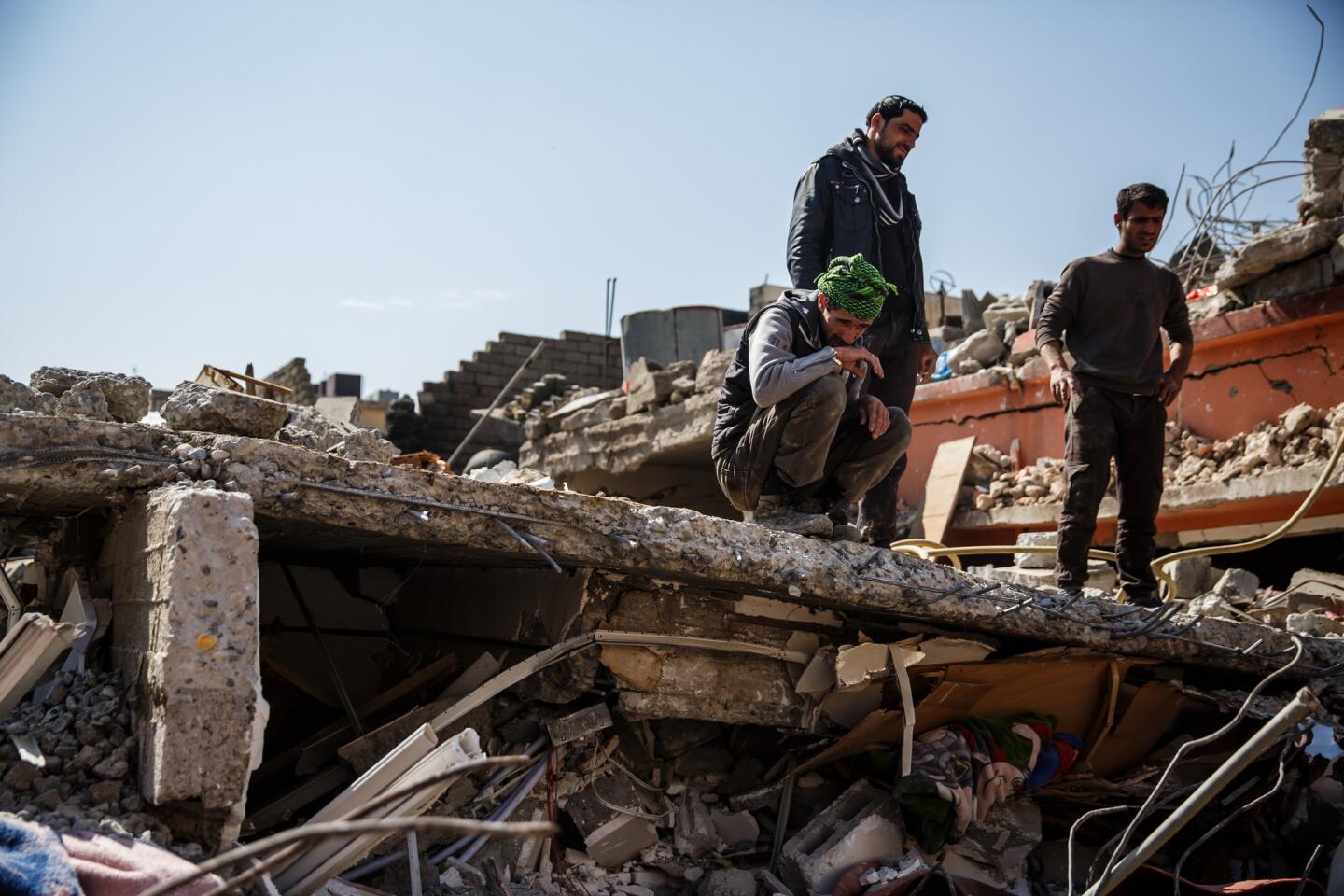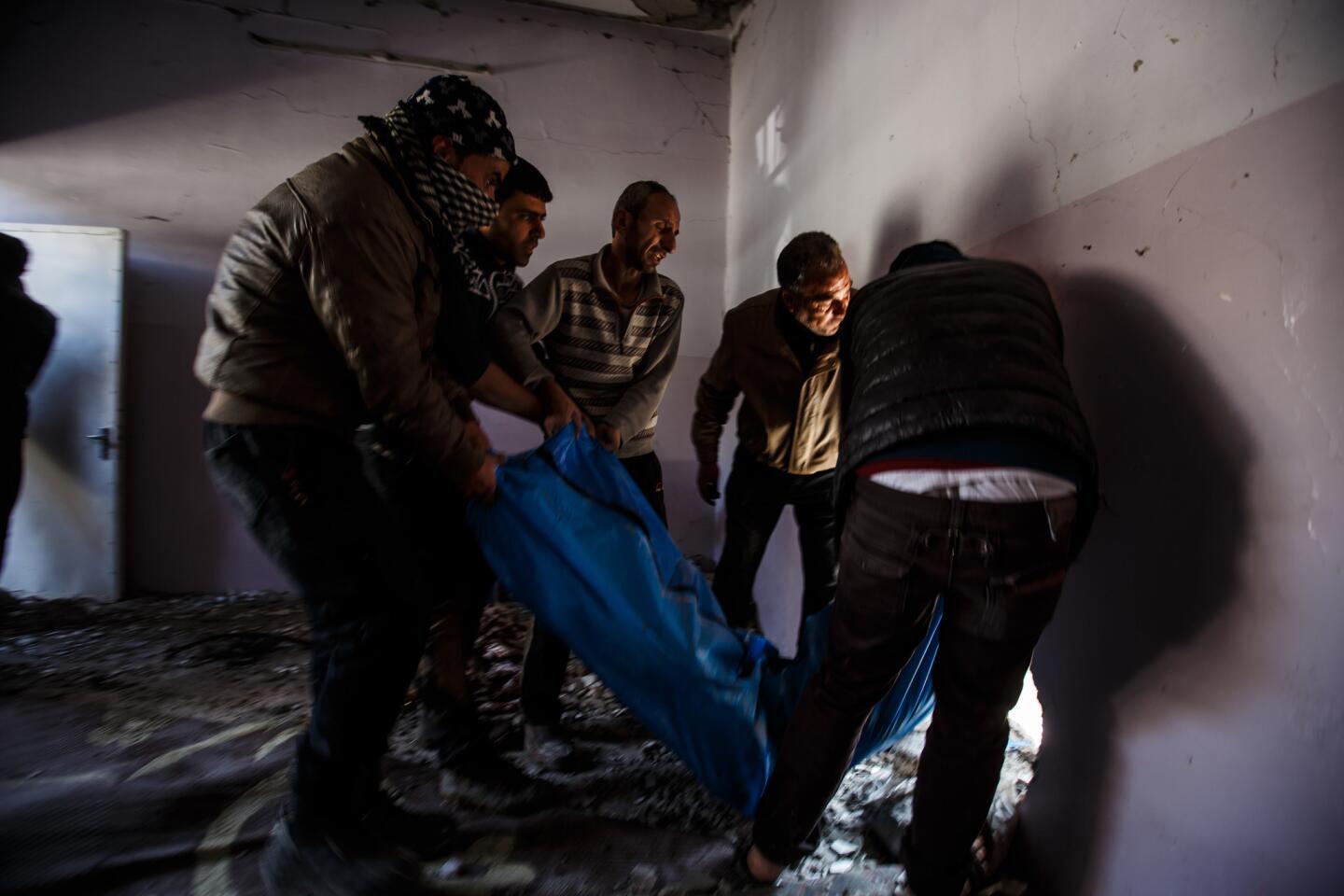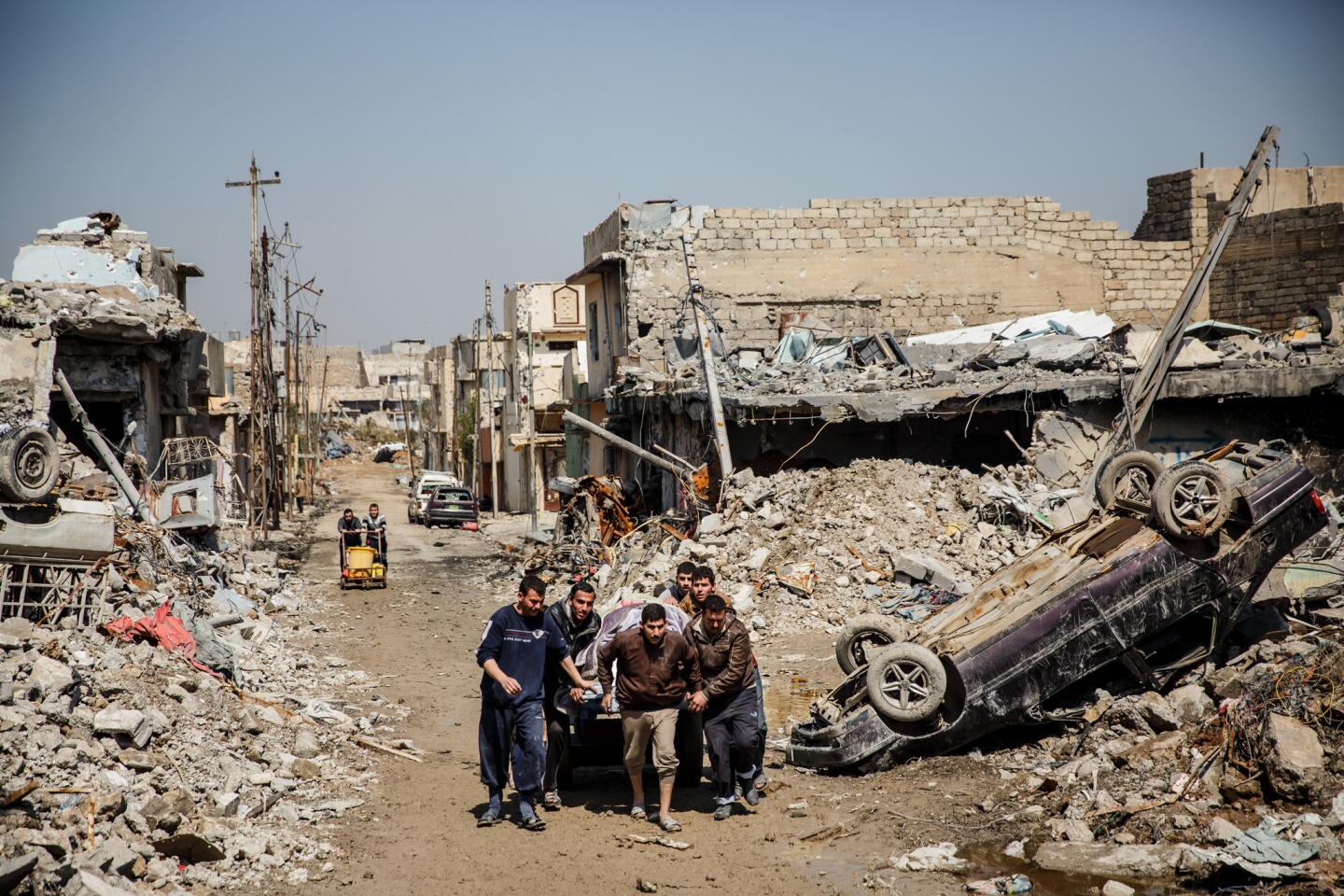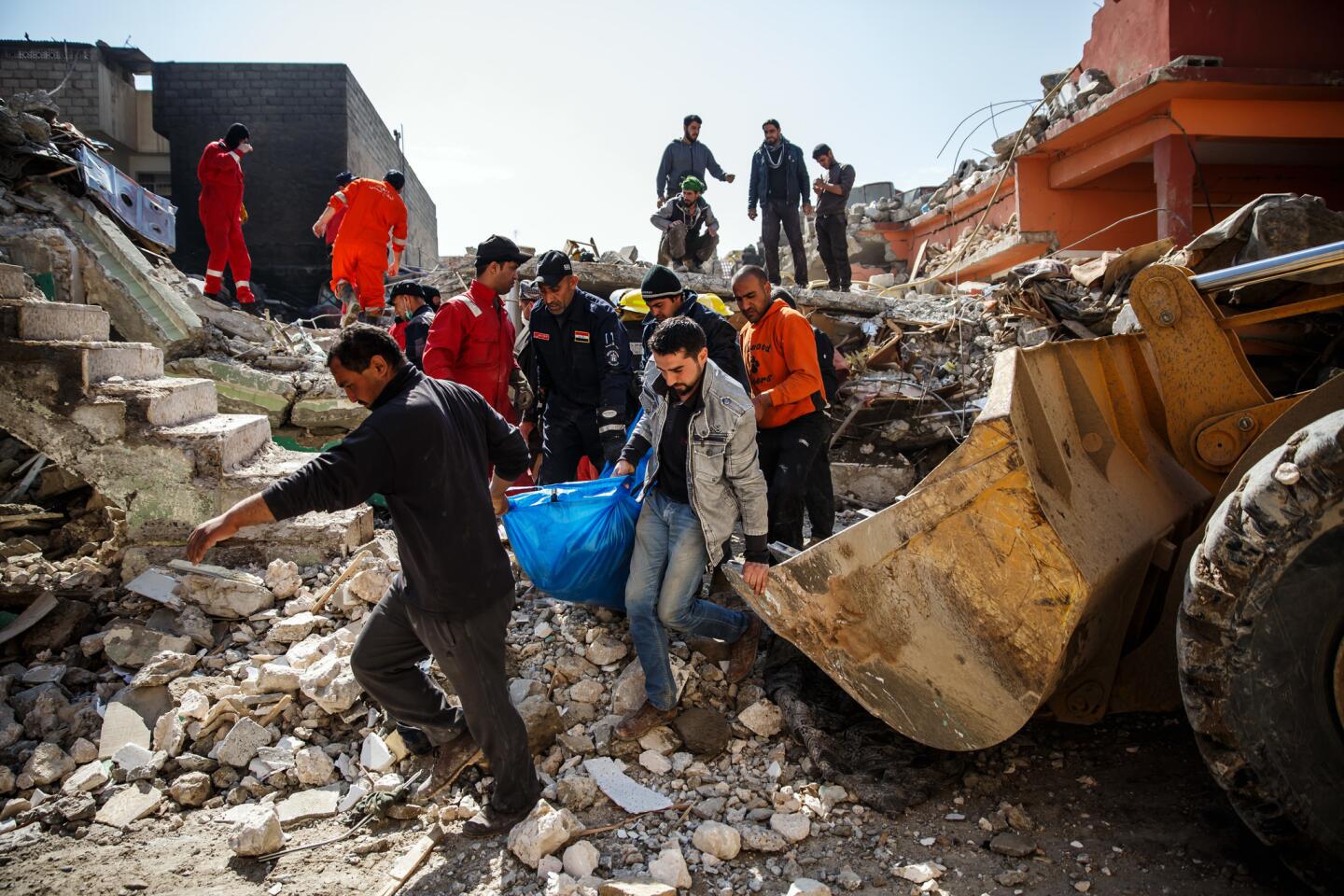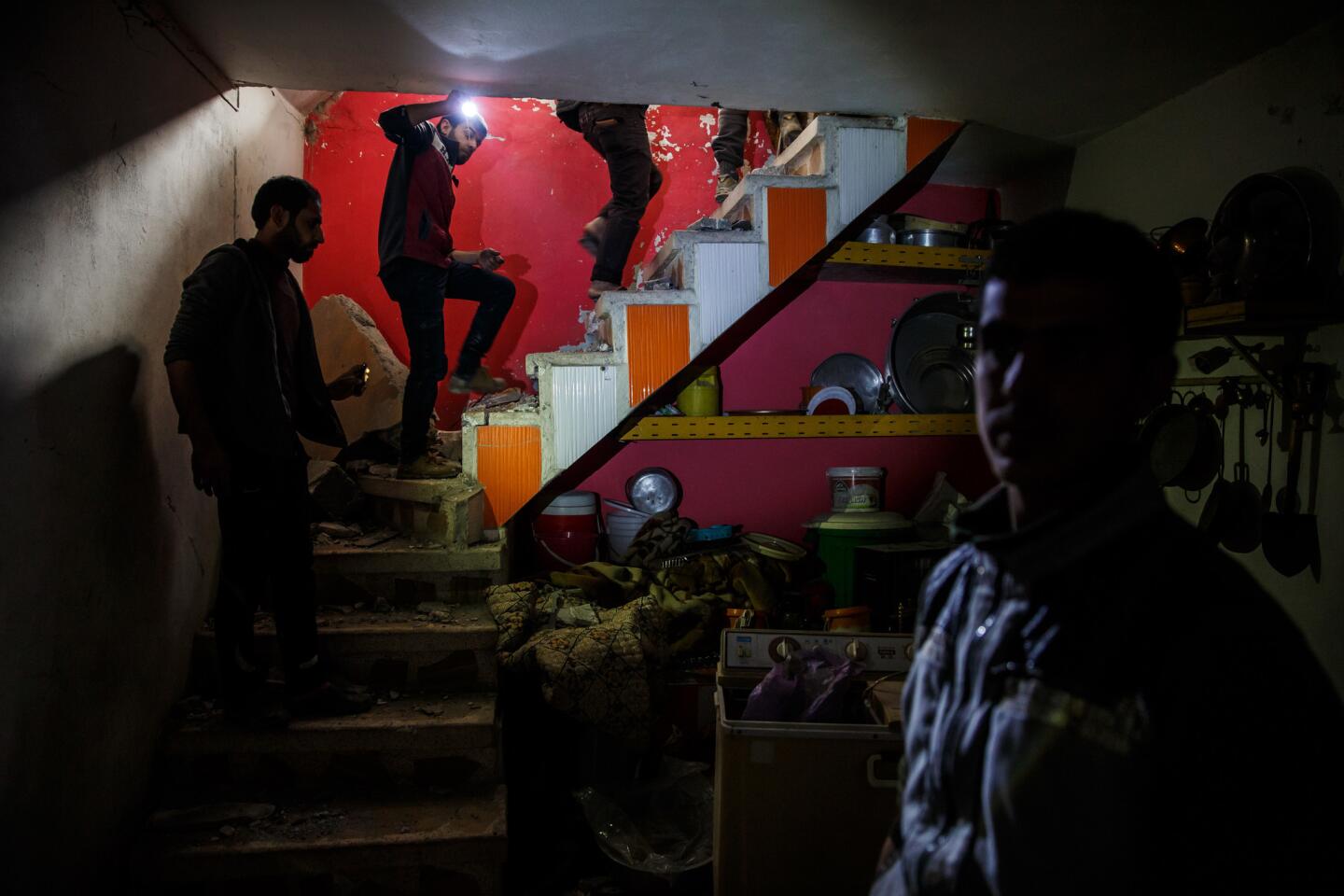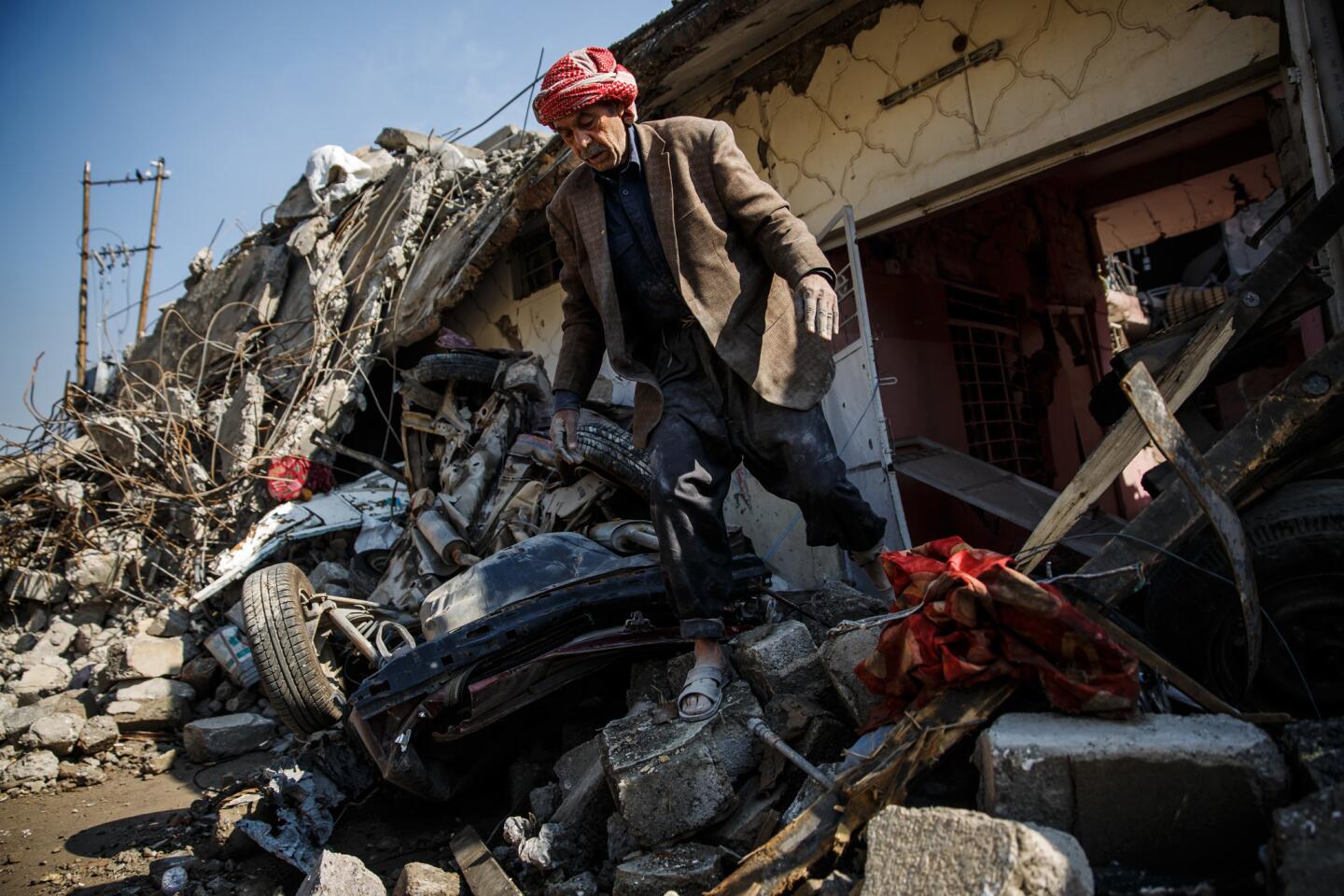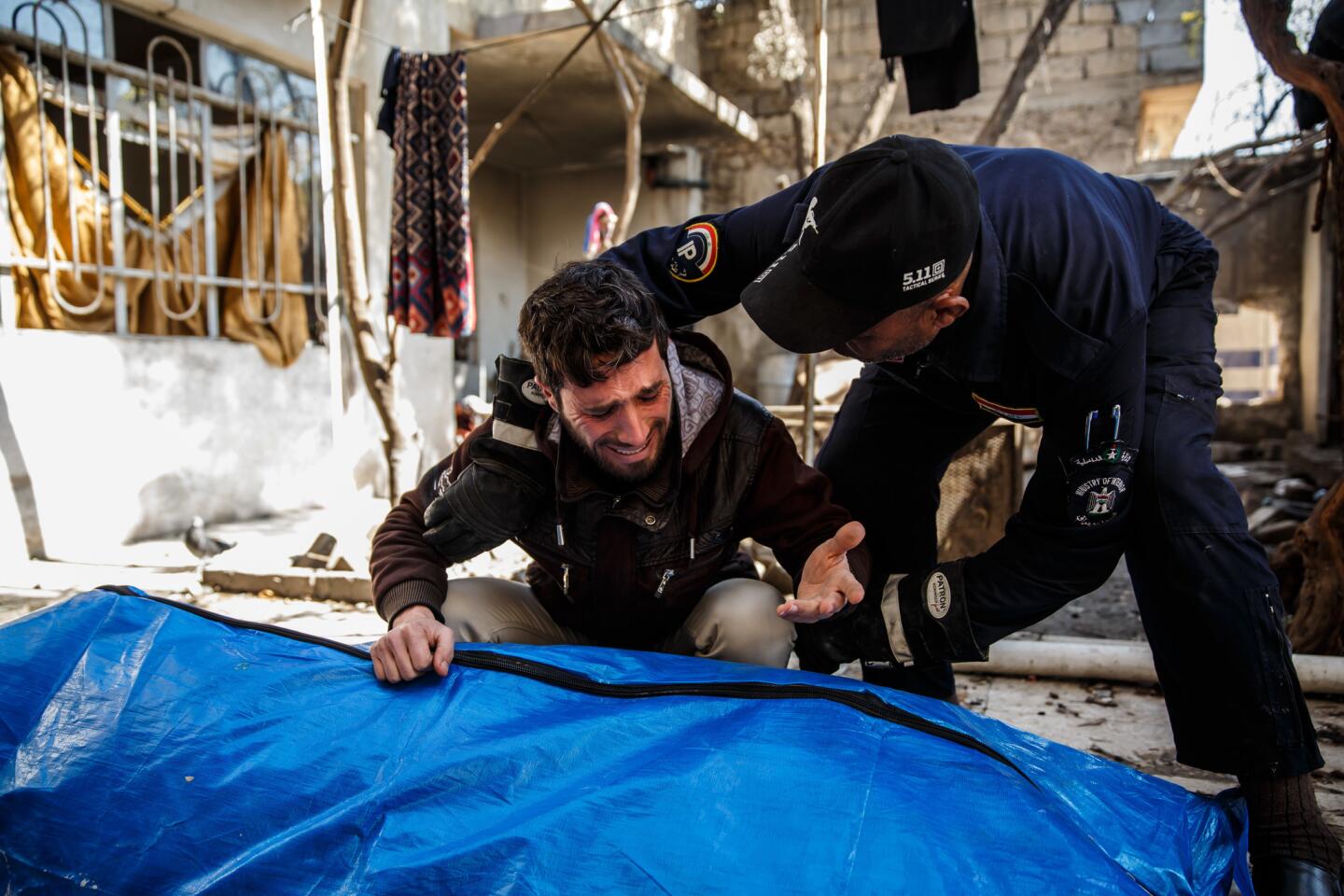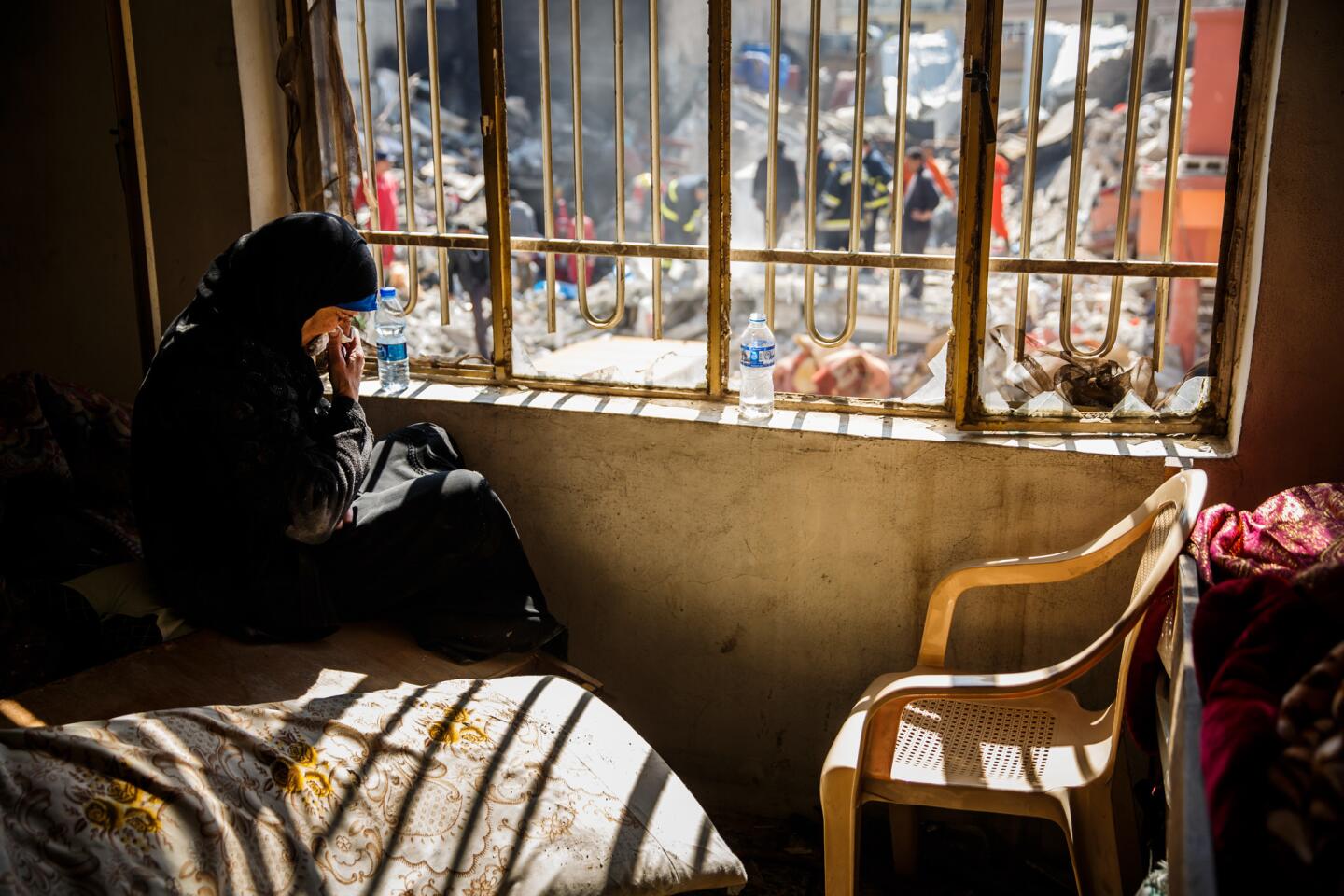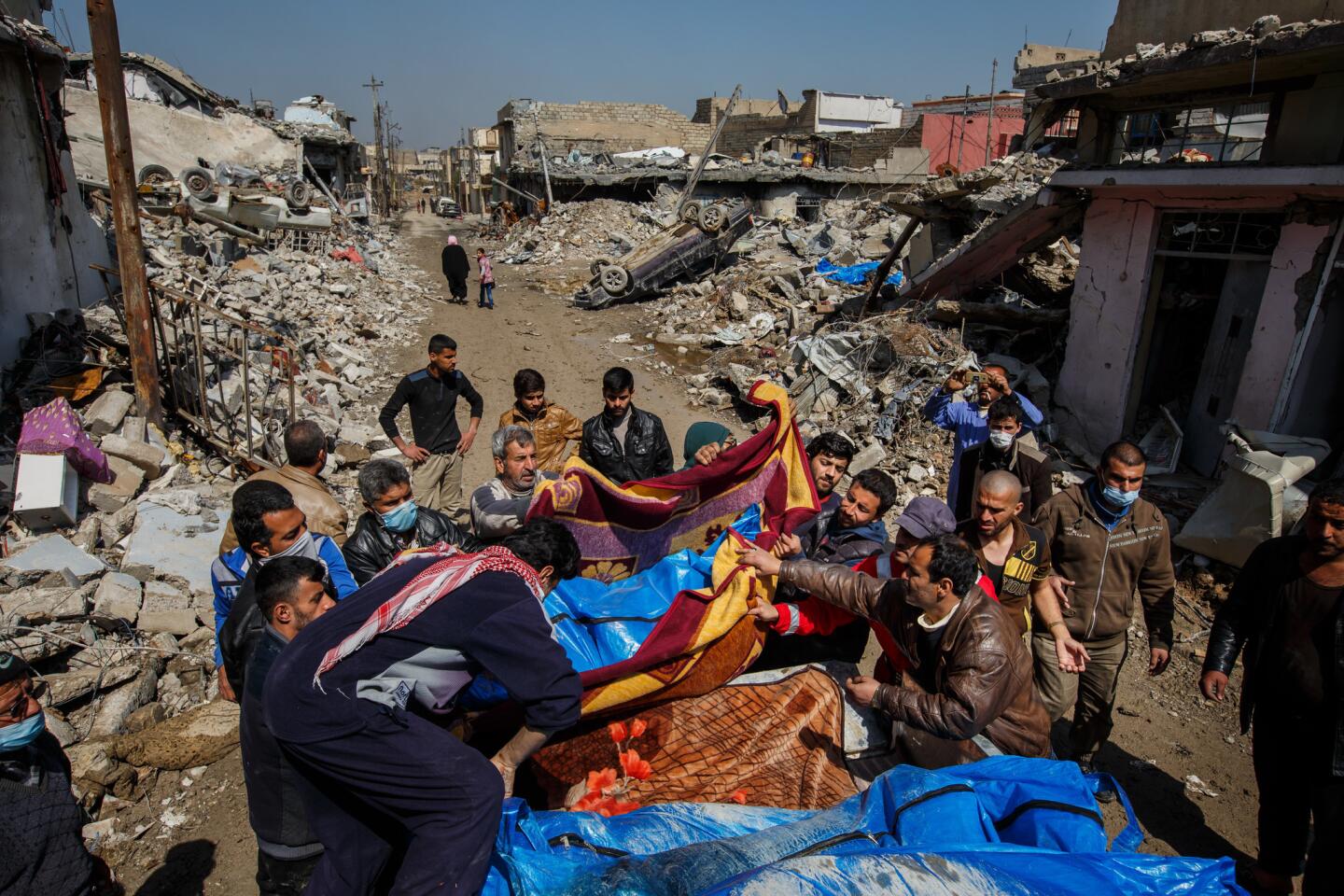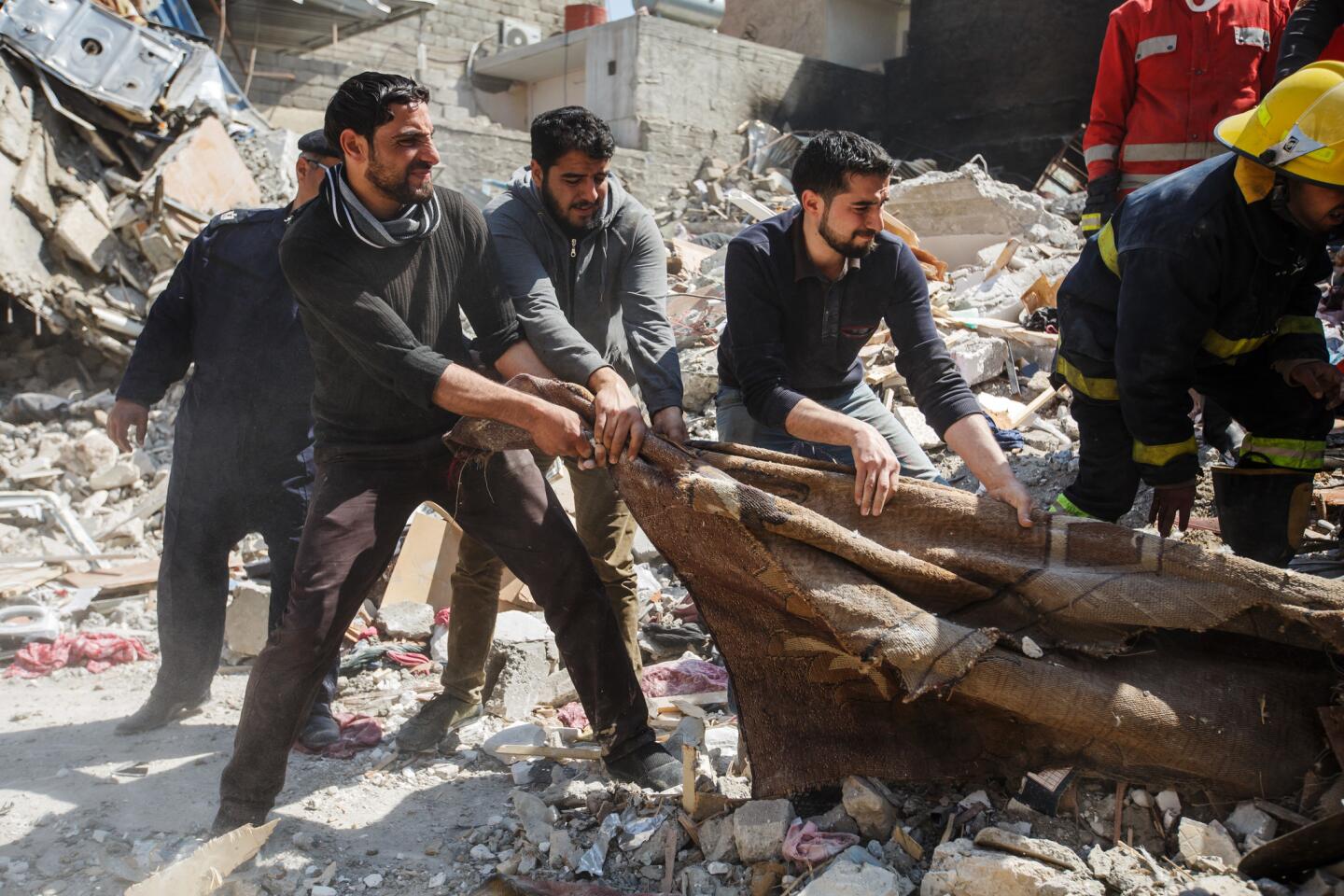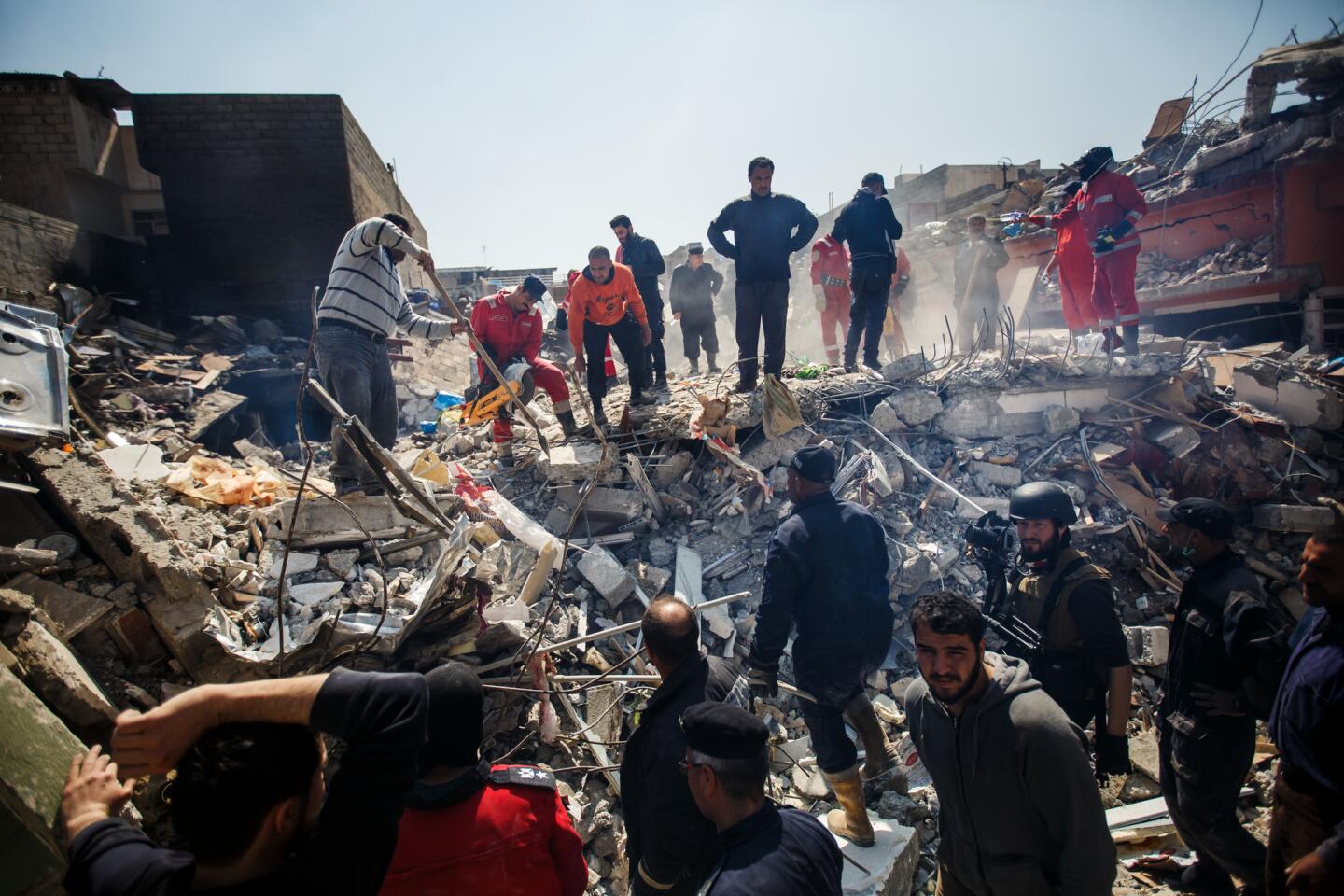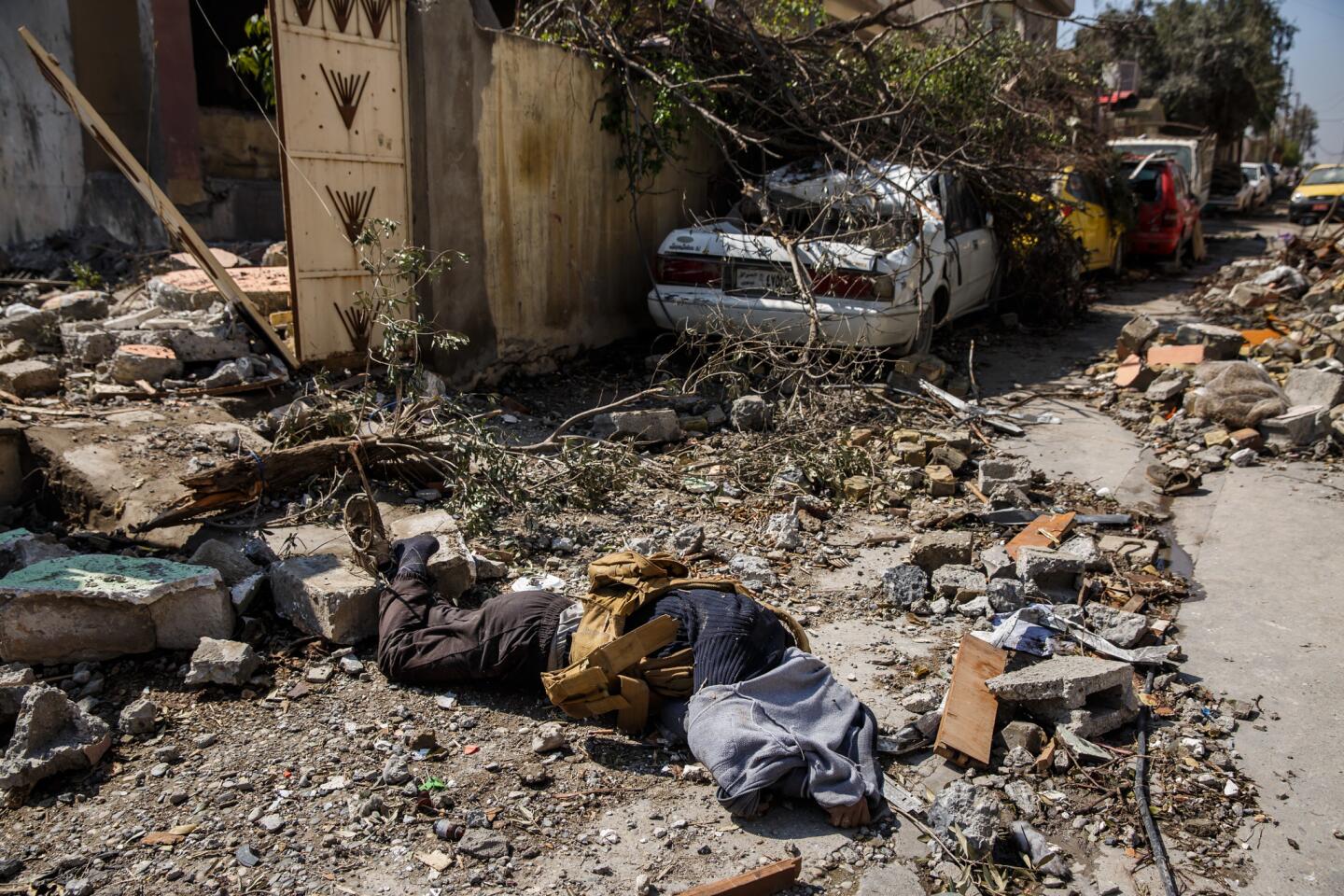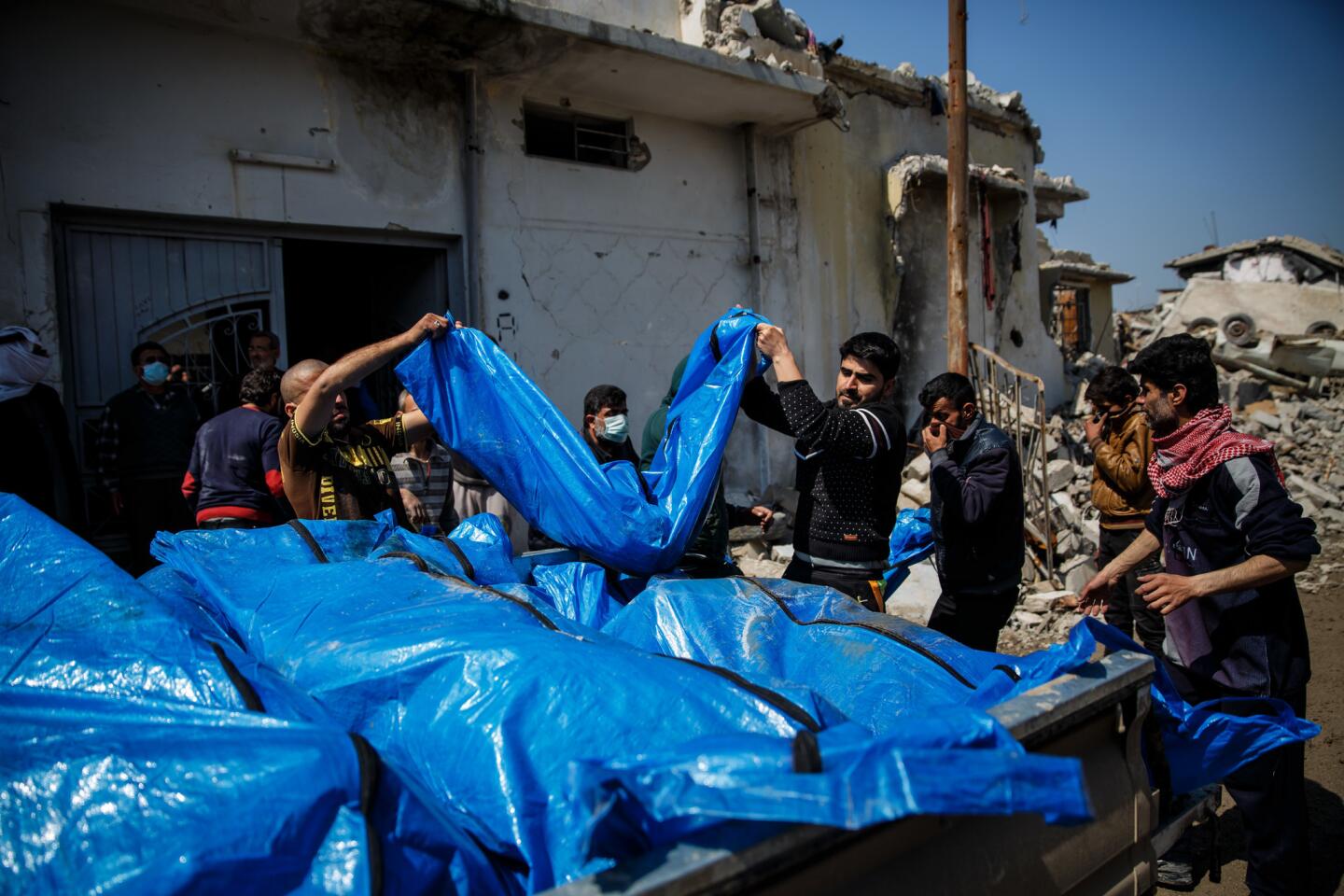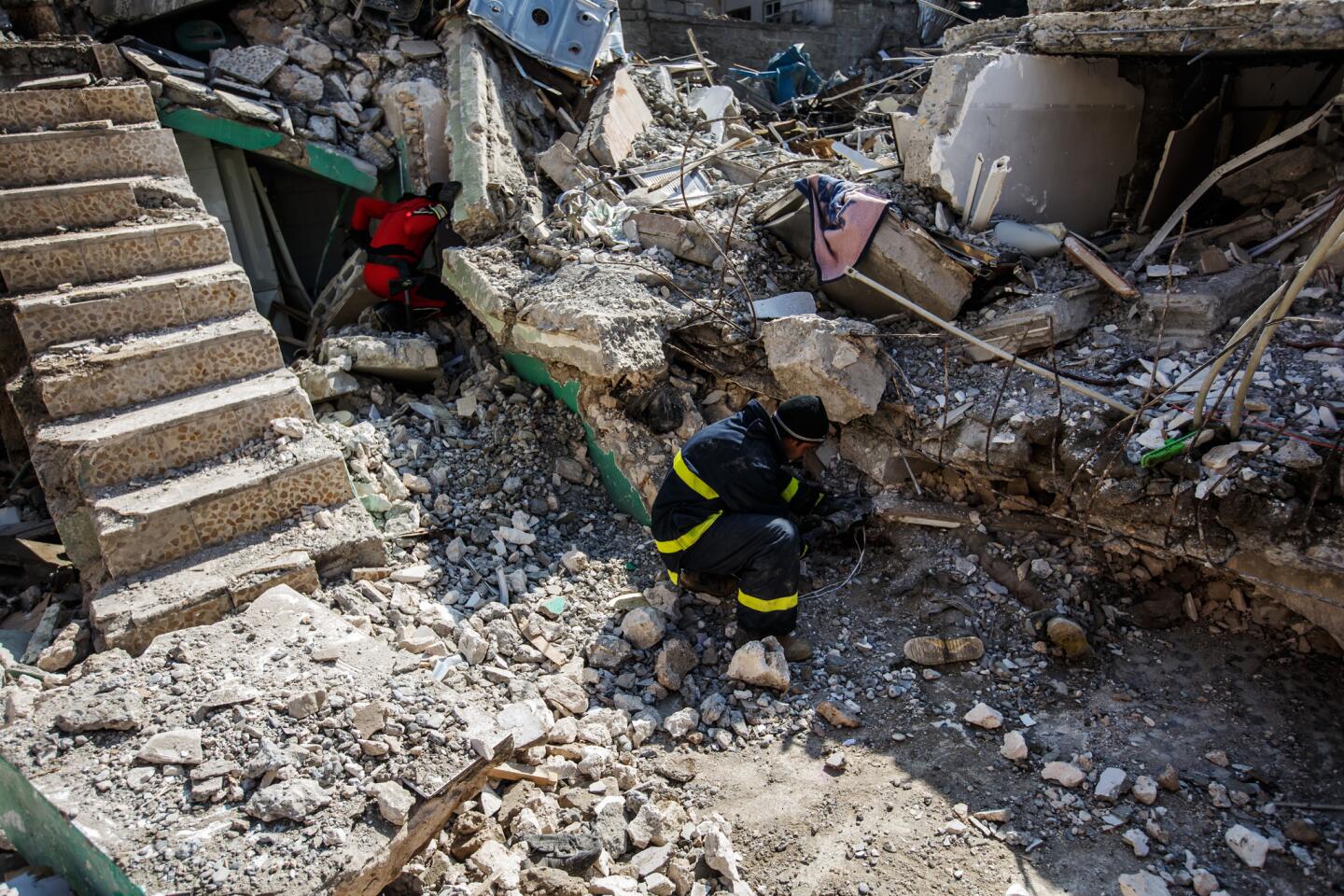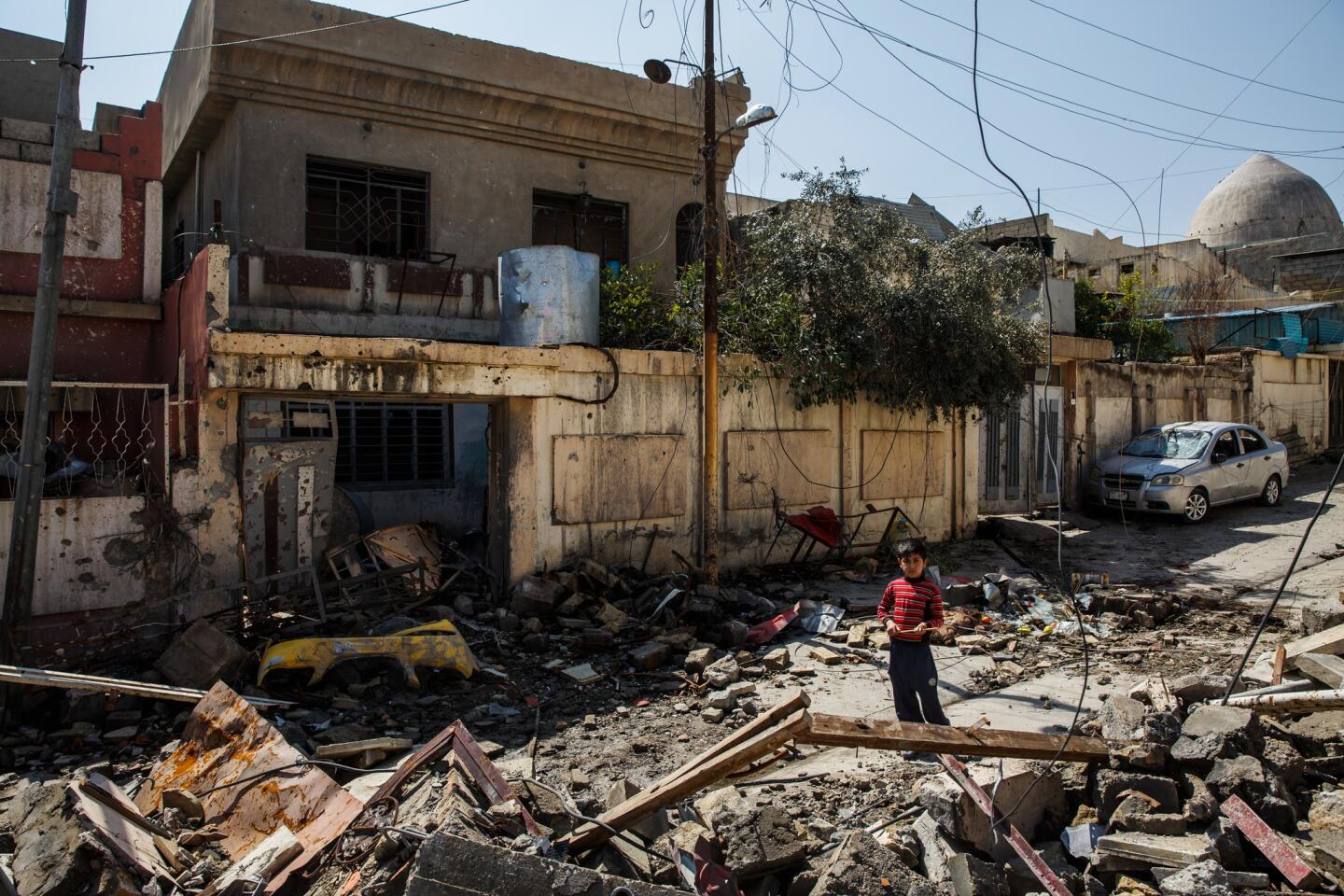More than 200 civilians killed in suspected U.S. airstrike in Iraq
- Share via
Reporting from Mosul, Iraq — Munatha Jasim watched Iraqi civil defense workers in red suits scurry among the ruins of her neighbors’ homes Friday, extracting the dead and zipping them into blue body bags.
The massive explosion that tore through Baghdad Street last week killed nine of Jasim’s relatives, including son Firas, 7, and daughter Taiba, 4. “We recovered half his body,” she said of the 7-year-old. “The rest is still there.”
The U.S.-led coalition in Iraq is investigating whether it was responsible for an airstrike in the west Mosul neighborhood of Aghawat Jadidah March 17 that local civil defense officials said killed at least 200. It would be the highest civilian death toll from an airstrike since the battle against the militant group Islamic State began more than two years ago and among the deadliest incidents in modern warfare.
“The coalition has opened a formal civilian casualty credibility assessment on this allegation, and we are currently analyzing conflicting allegations and all possible strikes in that area,” said U.S. Army Col. Joe Scrocca, a Baghdad-based spokesman for the coalition, who added that coalition forces routinely strike Islamic State targets in that area.
Scrocca said the investigation is looking at “multiple allegations placing a strike in the area sometime between March 17 and 23.” The Pentagon previously announced four strikes near Mosul March 17 that destroyed 25 fighting positions, 56 vehicles plus a suicide car.

U.S. officials, who weren’t authorized to speak publicly about the ongoing investigation, said initial indications are that a truck loaded with fuel or explosives may have been inadvertently hit, causing a massive explosion that killed over 200 peop
“We will continue to assess the allegations and determine what if any role a coalition strike may have had in that area,” Scrocca said.
Nearly 50 bodies could be seen Friday in the area of the alleged airstrike, where relatives helped recover remains.
One man approached a bag that contained the body of a pregnant woman, touched it, talked to it, then began to cry and wail. Civil defense workers had to lead him away.
In a nearby garage where bodies were being stored, another man who lost 32 relatives tried to identify them based on what had been recovered: some government identification cards, a brown wallet and a black purse. But he started to sob, and had to step outside, sit on the curb and hang his head.
Jasim walked down a dirt street that reeked of death. Bodies were still pinned under houses; blackened hands and a pair of feet in yellow high-top sneakers protruded from one place in the rubble. Finally, she stopped and pointed to the ruins of her home. She said a militant sniper had set up across the street from her house before the attack.
“Just because one Islamic State [fighter] was on our house, the aircraft bombed us,” she said tearfully.
Residents who witnessed the explosion said it came after militants forced them into their homes.
Scrocca said Islamic State’s use of civilians as human shields has been a challenge for coalition forces in Mosul.
U.S. officials, who weren’t authorized to speak publicly on the ongoing investigation, said initial indications are that a truck carrying fuel or explosives may have been inadvertently hit, causing a massive explosion.
The incident is the latest of several fatal attacks in which dozens of civilians are alleged to have been killed at the hands of U.S. forces.
On Wednesday, humanitarian groups said at least 30 civilians were killed when an airstrike hit a school in Syria, south of Raqqah. Less than a week earlier, the U.S. was accused of bombing a mosque in Aleppo province, killing more than 40.
The two incidents are being investigated by the Pentagon.
Despite the mounting allegations, the U.S. is quick to say that no military in history has taken such pains to avoid civilian casualties, and that nearly every bomb dropped is guided by satellite or laser.
“Our goal has always been for zero civilian casualties, but the coalition will not abandon our commitment to our partners because of ISIS’s brutal tactics terrorizing civilians, using human shields, and fighting from protected sites such as schools, hospitals and religious sites,” Scrocca said in a statement, using an acronym for Islamic State.
As the battle has moved into a city of narrow pathways and clusters of shops, homes and Muslim shrines, the U.S. military has launched an unprecedented number of airstrikes to help Iraqi forces advance. U.S. pilots describe dozens of strike aircraft circling high above west Mosul, waiting their turn to drop a bomb.
The U.S.-led coalition has unleashed more than 500 aerial bombs, artillery and mortar shells, ground-launched rockets and drone-launched missiles this week, which follows 880 the week prior. More than 18,400 munitions have rained down on Mosul since the offensive began on Oct. 17, according to the Pentagon.
Delivering those strikes without laying waste to the ancient city and the civilians who live there has proven difficult as the militants mix among communities.
The military is investigating more than a dozen reports of civilian casualties in Mosul alone.
Civilian deaths have long poisoned Iraqis’ relationship with the United States. To mitigate against the deaths, U.S. military officers and air controllers embed with Iraqi forces to direct airstrikes against Islamic State positions and advise Iraqi ground commanders on how best to advance on the battlefield.
Lt. Gen. Jeffrey L. Harrigian, the top Air Force commander in the Middle East, said in February that U.S. advisors had been granted greater authority and, rather than going through headquarters, now can speak directly to pilots so that strikes can be launched quickly.
The U.S. military employs a lengthy set of precautions, including written rules of engagement and multiple levels of approval before bombs can be dropped or missiles launched. Still, the nature of the war in a dense, heavily populated environment guarantees more accidental deaths, especially when people make split-second life-or-death decisions.
This month, The Pentagon substantiated nine of 19 alleged instances of airstrikes with civilian casualties from January, resulting in two injuries and 21 deaths.
The Pentagon has acknowledged 220 civilian deaths from coalition airstrikes in Iraq and Syria since the U.S. campaign against Islamic State began in 2014.
Airwars, a London-based nonprofit that monitors civilian deaths from coalition air raids, put the casualty figures much higher, at about 2,700 civilians killed in airstrikes in both countries during that time.
Chris Woods, director of Airwars, said his analysts were overwhelmed with the spate of recent allegations.
“Reported civilian deaths from coalition strikes have been rising for some months, but where we’re at now — with more than 1,000 claimed fatalities so far this month — is unprecedented,” he said. “I don’t think any of us at Airwars expected to see allegations against the Coalition running so high — even with the predicted high risk to civilians during the Mosul assault.”
The Iraqi government was also looking into the alleged airstrike last week, said Brig. Gen. Tahsin Ibrahim, spokesman for the ministry of defense.
“If we hit civilians there is a big investigation,” and if the investigation finds sufficient evidence, the case may be referred to a military court, he said.
Civil defense workers and witnesses at the scene of the alleged airstrike late Friday said it came in response to militants who had fired on aircraft in the area. Some said they saw only a few militants, others said they saw 10.
Iraqi Civil Defense Lt. Col. Taha Ali said the airstrikes came after militants began shooting at aircraft with “heavy rockets.”
“That’s why the aircraft fired,” he said, adding that he didn’t think Iraqi or coalition forces were to blame. “It’s Islamic State’s fault because they were shooting. If you shoot, they’ll shoot back … the army is just doing their job.”
Several witnesses described being forced into their homes before the airstrike by militants who burned their cars, parked a truck packed with explosives next to a house and perched on a roof, firing weapons.
“Daesh was not letting us go out,” said Ihab Adnan, 35, a laborer, using a common term for Islamic State as he picked his way through the remains of his uncle’s house next door.
Adnan pointed to a photo in the ruins of his 13-year-old cousin, Ali Ramadan, whose body was now zipped in a body bag.
He said a series of airstrikes began at just after 5 p.m., and “everything was exploding.”
He could hear his relatives screaming next door. Adnan was screaming, too. He emerged to discover several families had been buried in their collapsed houses: 18 in his uncle’s house, 72 in a nearby home, 130 in another. He could hear some of the injured crying.
“We were running and taking people out” of the ruins, Adnan said.
Officials at an Iraqi military clinic nearby said they treated more than 20 survivors.
Truck driver Rayid Najim Abdullah said he felt an airstrike hit his home and then ignite a truck packed with explosives parked nearby.
“The house just fell on us,” said Abdullah, 48.
His wife and three children, ages 12, 10 and 5, were all hospitalized Friday. Abdullah also had a cut on his nose, and looked bereft.
“I lost my car and everything,” he said, gesturing at the remains of his street.
Majid Taib Najim, 47, was sheltering inside his house with 40 relatives when he saw aircraft bomb the area, striking his house and the truck. He said they were lucky to escape unharmed.
“All the people that died here is because of a mistake by the aircraft,” Najim said.
Suha Khalid Gharab, 60, lost 20 relatives in the explosion, including a 1-year-old.
“It’s a crime, killing civilian people,” she said as she sat inside her damaged house Friday, surrounded by neighbors.
Some called for families to be compensated by the government, so they can rebuild. Others wanted assurances that civilians would be better protected by Iraqi and coalition forces in the future.
“This is how they’re liberating the area?” asked Ahmed Abd, 43, a laborer.
Iraqi civil defense teams first reached the area Thursday, extracting 40 bodies. They made slow progress Friday extracting 42 more bodies buried in several feet of rubble, at times relying on a jackhammer, whirring blade and a bulldozer to clear mounds of debris from a collapsed house where 130 are believed to have been buried.
Saleh Jamal, a longtime civil defense worker, surveyed the scene from a garage full of body bags nearby and said it was the worst he has seen in 30 years outside of Baghdad, comparing it to the deadly bombing of the capital’s Karada district last year that killed about 300 people.
“Yesterday we brought up 10 small children,” he said, shaking his head.
Turkya Azudin sat in an empty room above the garage, watching the teams at work below and counting relatives she had lost: 18.
Neighbor Marwan Saleh, 50, sat next to her, awaiting word on the bodies of his daughter, son-in-law and 2-month-old grandson.
“They’re still in there,” he said, gesturing to the collapsed house and vowing to keep vigil “until I recognize them.”
Saleh said he hopes Iraqi forces learn from the deaths on Baghdad Street.
“It’s too much, all these airstrikes on this one area. Why?” he said. “Liberate another way, not this way.”
Times staff writer Hennessy-Fiske reported from Mosul and Hennigan from Washington, D.C. Times photojournalist Marcus Yam contributed.
molly.hennessy-fiske@latimes.com
Twitter: @mollyhf
Twitter: @wjhenn
ALSO
U.S. aid group provides medical help to Iraqis near front lines in Mosul
PHOTOS: Deadly airstrike in Mosul kills scores of civilians
East Mosul may be free from Islamic State control, but it’s far from secure
UPDATES:
3 p.m.: This story was updated throughout with additional details from the scene of the explosions.
This story was originally published at 11 a.m.
More to Read
Sign up for Essential California
The most important California stories and recommendations in your inbox every morning.
You may occasionally receive promotional content from the Los Angeles Times.
